MDFCs are effectively utility lands but they function a bit differently which in turn effects how you build with them. They are front loaded and locked in. You either make a land or play a spell. Almost all other utility lands are both a mana source and an effect in some way or other. Some have EtB effects, some tap effects, and some sacrifice effects. In all those examples you get to have both the land and the effect. The EtB ones give you the effect right away and are from then on just lands. The tap ones always give you that option of mana or effect each turn. And the sacrifice ones are lands until you use the effect and then they are spent. The only type of lands that operate in the same way as MDFCs are cycling lands. They are either just a sub par land or something else, you never get both the land and the utility. With cycling lands it is a random card from your deck while the MDFCs are a specific and known thing. Cards from your deck are much better than the spells on the other side of lands, but once you add the cost of cycling onto the random card in your deck it gets a whole lot closer. Add onto that the information advantage you have with an MDFC compared to a cycling land where you know exactly what the alternative to the land is and how useful that is going to be in the context of the game at hand and on average you wind up with a better deal on your MDFC. This is one of the many nails in the coffin of cycling lands these days, or at least ones that don't tap for loads of colours of mana!
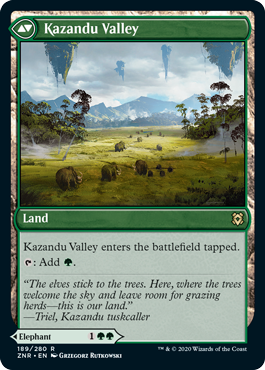
On the better MDFCs the spell portion is about one mana off par for what is a good cube card. That makes them quite a bit better than the consistency offered by a cycling land. It means these cards are very playable on the whole. None of them are bad in a limited cube setting, although some are certainly far better than others. They do however all suffer partly from cube bloating as other mono colour utility lands. As the MDFCs are a bit more 50/50 on being a land or a spell they are more akin to replacing half a basic land rather than a full basic land in your list and as such not quite as much of a luxury or a bloat on your cube as other utility lands. Never the less I have had to cut back on these more than I would like to so as to keep the cube streamlined. These original land MDFCs allow for some really interesting deck building choices and do a great job of making you a lot more consistent in game. Even the weaker ones add a good amount to decks and so I am sad whenever it is time to cut one.
The best of the cycle (can a cycle be 30 cards?) tend to be those that are closest to 50/50 on which side of the card is played. Simply put, the further away from the centre point you move the more it implies you should either be running a basic land or a similar sort of spell depending on which mode you are tending to use most. This means a lot of the more expensive or more situational spells were getting used as lands rather more of the time. This is where I initially misjudged the five mythic lands that can enter untapped. Yes, their inclusion cost is lowest but their high mana costs mean you rarely use the spell resulting in a low impact card overall. You want the spell to be relevant when you play it and you want to be using a mix of both sides of the card as well. Low use or low impact can both be terminal for an MDFC fighting for a cube slot.
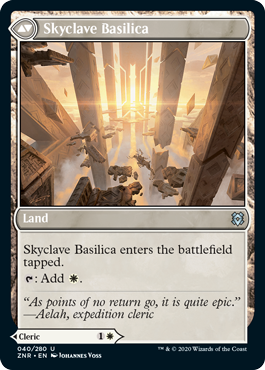
Due to the way these MDFCs work there are some unique scaling aspects at play that relate to how well the effect is in regards to being modal alongside a land drop option. These are quite subtle and seem to need a card by card appraisal based on how they function on top of some general trends. Those are as are as follows. The nest modal cards are good when they have a situational mode and a generally useful modeand a land is the latter and so presumably more situational spells on your MDFC are better? Well, as I have already said, that reduces the times you play the spell which rather lowers the impact of the MDFC overall, both from being a bad land and from being that land side well over 50% of the time. This tends to make them not worth the bother in cube what with a low impact effect with low frequency of occurrence raising no one's pecker. There are however two kinds of situational. There are those that depend on the game state such as a combat trick, there are then those that depend more on the point in the game, ie cards that are specifically good earlier or later and not throughout. This latter group seem to have done very well out of being given the MDFC treatment. Due to the effects of higher costing cards getting cast less that we covered earlier this tends to mean that most of the best MDFCs for cube are those that have spells you want early. This is simply because they necessarily have to be cheap cards. There are however a couple of cheaper spells that scale rather better the later you use them that are high performing MDFCs as well.
It does seem a little counterintuitive. You want meaty spells when you are flooded and lands when you are screwed and so just by that logic the more powerful and more expensive MDFCs sound like they would have the most impact. That isn't really taking any of the subtleties or complex lines of scaling into account. The precise nature of the modality, the effect of the spell, the archetype you would look to run it in, etc. The easiest way to appreciate that aspect is comparing it to an alternate utility land best used as a mana sink. Generally I prefer good creature lands, the Castle cycle, the likes of Kessig Wolf Run and even Barbarian Ring a lot more than the various high mana MDFCs. They all perform the same sorts of role in the late game however the MDFCs do it worse and in a less useful way. A 4/5 trample might be better than Den of the Bugbear but it is wasting the opportunity to put a threat on a land thus stretching your opponent thin on answers. You also get to make the land early without wasting the utility as MDFCs do. What sounds like the worst land for your deck out of Umara Skyfalls, Castle Vantress, and Hall of Storm Giants? Skyfalls feels worse both as a land and as a mana sink. It is not so much that the more expensive MDFCs are bad or anything. It is simply that the other kinds of utility lands scale better into the sorts of game states where those sort of things perform thus jumping ahead of them in effectiveness.
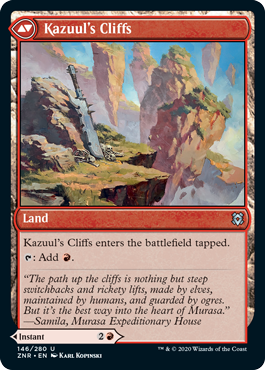
I am still in awe at the design on the MDFC lands from Zen Rising. They do such a good job of representing the colour pie range while being fairly clean and simple cards. Most impressively of all this was achieved without having broken or unplayable cards at the extreme ends of the power range. I shall start at the bottom end of the rankings and work up to the best of these 30 MDFCs for cube. I am foggier on the precise positions of the bottom end as they were some of the more obviously unsuitable cards in cube and received rather less testing than the rest consequently. These will come in three blocks. The weak ones you shouldn't really bother with despite still being better than most utility lands ever printed! The fine ones that are all cube worthy but a little bit on the luxurious and consumptive of space side of things. Finally the really good ones that remain in my cube.
Block 1 - The Least Good Lot
Makindi Mesas 5/10
I am somewhat stunned this is my pick for worst of the lot. Functionally it is quite potent and suitable. It is a good alpha strike Overrun effect for white aggro decks. The problem is all to do with multiple small issues stacking up. Being a five drop this is very late. It is situational based on the board state. It is narrow for really just having one broad archetypal home. The cost of entering tapped is a big one for that home. Basically you rarely play the spell portion and so that portion of the card adds very little to the package resulting in mostly just a bad land. Plains outperforms this a lot. It isn't so much that this is worse than a plains it just isn't really better either and that makes it super hard to justify having in a cube. In deck building as well a card like this might take up some of your small allowance for an EtB tapped land thus imposing opportunity costs too. I suspect this gets better in more budget cubes where I would expect aggressive white decks to more commonly still be in the game and it still to be relatively early by the time they hit five mana. For my testing this felt like it came too late too often.
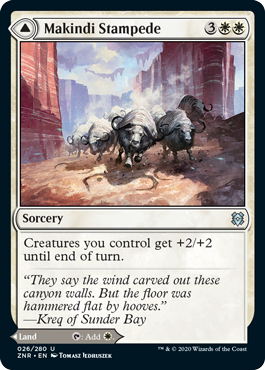
Zof Bloodbog 5/10
A nice bit of reach and lifegain for a colour that likes both. Being a very late game spell that often does nothing when life totals are not the main focus this is just far too infrequently useful to merit play. The only reason this is above Stampede is that Consumption actually won a couple of games and felt like it was a far more interesting card as far as planning goes whenever I drew it. Mostly of course I was just forced into making it as a land long before the six mana mark amd nothing else better to do with it mark.
Sejiri Glacier 5/10
Situational in a game state context rather than game stage - the bad kind. Higher cost on these kinds of protection effects really hurts their performance. They are also cards you want in tempo decks and so relatively high spell cost or EtB tapped land both fail to appeal. Are you holding this in hand? If so are you then holding up two mana for it? Doesn't sound ideal. It can do work countering removal, saving a dork in combat or forcing through a dork in combat but so do lots of better spells.
Khalni Territory 5/10
I was surprised at this one underperforming what with green lacking much in the way of removal. This card suffers a number of problems. Many are with fight cards in general such as when when you have the bigger dork you need removal a bit less. The other is that they can be risky and are unreliable both based on what disruption your opponent has and what fight ready dorks you have. Specifically to Ambush the rate you pay is poor even despite the MDFC tax and thus the power is rather lowered. It also makes finding a window of safety to use it that much harder. It is the kind of tool you want to generate tempo with but the high spell cost on an EtB tapped land harms that potential.
Blackbloom Bog 5/10
This just sits in an awkward middle ground of being good at no point in the game. On curve this is low threat, low tempo and low value. It just looks awful lined up next to any three drop. I wouldn't play Rogue at two mana... By 5 mana or so when you start to reach the top of your curve this guy is even more pathetic. It might be more efficiently costed than some of the bigger dorks on MDFCs but the nominal power is too low when combined with being well below cube power levels.
Beyeen Coast 5/10
This one might be cheap but is is both situational and low power. I have had it be good but not often enough to merit inclusion. Typically even when it is good it is just buying you a bit of time, you still need to find or use other things in order to not just die. There is no real disruption. You lose a card, spend some mana and don't really waste any of your opponents mana either. This is just a situational lifegain spell. When saving planeswalkers it is nice but at two mana to use your planeswalker probably already died.
Akoum Teeth 5/10
Comically bad mana efficiency but sufficiently high nominal power to be a somewhat relevant threat. This is simply more robust and more effective than Blackbloom Rogue. You can't cast it as easily but at least it does something when you eventually do. While I have had this win games it is too infrequent to merit playing in decks or cubes for the most part. You cast this a fraction of the times you drop it as a land and of those times you cast it mostly it dies or just sits about doing fairly little.
Block 2 - The Useful
Umara Skyfalls 5.5
Slightly cheaper than Warrior and arguably better evasion at the cost of two toughness. This is a little easier to answer but is just as much of a threat. The lower cost helps it get cast more as does being blue with games tending to go longer. Indeed, later on answers are fewer and father apart thus negating the lower resilience. A long way from a bomb but a good way to add some threat or some gas to aggro, midrange. and control decks. This is about the point at which these cards start to be viable cube inclusions. They add so much consistency and options to decks and the building of them that even the lower powered offerings have value. For unpowered and depowered/peasant 720 cubes there is an argument for including all the cards from this point onwards. I wouldn't Wizard outside of a big budget cube but it will perform reasonably where ever you slap it. I prefer a Faerie Conclave to this for being more of a diverse threat and more roundedly useful throughout a game. That being said, this will end a game much quicker and is a more mana efficient dork with a much greater board presence. Conclave is not directly better by any means.
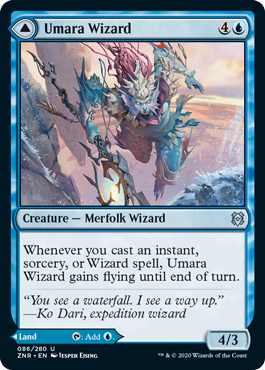
Song-Mad Ruins 5.5
This is situational and quite pricy but it does have a decent "win the game" element to it. It is also a really annoying threat to have to play around. It is a bit like when you know they have a Daze, it is just a tedious little check you have to go through. Treachery also does some really nice scaling up with a sacrifice outlet. On the polar and cute side but a reasonable number of scalps for this offering. High price and situational keep this heavily on the land side of the scale but the higher performance on those few cast keeps it in the discussion.
Kazuul's Cliffs 5.5
A powerful effect but too situational to be consistently useful. Where this shines best is in combo decks based on Fling effects where it adds some really juicy redundancy to the whole build. Fury is usually only good when it is ending the game, as removal it is pretty awful. A bad land, a bad removal spell, or a very situational and risky burn spell to the face. Some scaling, some versatility, but mostly just a lot of below average things to be doing.
Vastwood Thicket 5.5
This is a nice cute little persistent combat trick that even has some scaling with the odd counter based effect. There are only two issues here and only one of them critical. The minor one is simply being a nominally low powered card. It is quite hard to make this worth a card, it has to win a combat or counter a removal spell and that is really rare thanks to the small size of the buff. The main issue is that mostly this is a tool for tempo and the reverse side is an EtB tapped land. As such any tempo you might be able to gain with Fortification one game is then lost with Thicket in another. The graft land doesn't have the combat trick aspect to it but it does give you everything else all together resulting in a card I much prefer using should the synergies call.
Kabira Plateau 5.5
I thought this would be better than it is but sadly not. It is unreliable as far as removal goes and often somewhat under par. You need 3 creatures for this to be OK and 4 or more for it to be good. You likely need six dorks to be able to reasonably kill as many dorks in cube as your typical black two mana removal spell does. Largely this is a card for an aggro deck on a land that is bad for an aggro deck. The removal is also so weak compared to what white can deploy that this just didn't get used much.
Skyclave Basilica 6
This proved quite a useful tool for control decks to handle aggression. A bit of life and a nice cheap little defensive body which does a lot of work against aggressive red openings and can often be the difference between a win and a loss. The issue here is that the scope is just so small. Aggro decks don't want this, nor do midrange ones due to the very low power the card offers. It is only control decks that want this and even then they are only using it Cleric side against a couple of archetypes. That isn't enough application to deserve a cube slot. Good cube cards want to do things in multiple places and perform well against a range of opponents.
Ondu Skyruins 6
This is a very powerful tool to have at your disposal. It has won a couple of games and been the focus of my game plan in many more. This is again mostly just a control tool although it does do work against more archetypes and has seen a bunch of midrange play too. The main issue facing inversion is being such a high cost you rarely have the option to play it. The more minor problem is simply that it is very hard to pull ahead with the card, at best it puts things back to even. Often control decks are looking to pull ahead using mass removal with cards like planeswalkers on their side. A card that really helps to make you feel safe just by having it in the deck but in practice that safety rarely merits the cost of having an EtB tapped lands and not a plains.
Valakut Awakening 6.5
This is some lovely card quality to have on a land but it is too pricy to function all that impressively in most normal cubes. You need spare mana and loads of dead cards in hand for this to do much and while it does do a lot in that setting it is a long way from often that you find yourself there. Using it on turn three or four to dig for things is falling behind. Card quality is best used to get lands or action and this is already a land and so the card quality mode is a little diminished in usefulness by being a modal land card. This does at least do a lot of impressive work in combo decks and cubes. The ability to reseed drawn cards into a library is handy. In singleton with 40 card lists it is often a necessity. Awakening is a valuable asset mostly in that capacity. Cards like Lukka, Coppercoat Outcast really appreciate this kind of support. I love having this exist but as yet I have not seen it do great things and don't see it having much place outside of the more exotic combo and synergy builds.
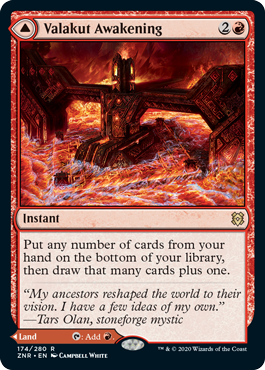
Malakir Mire 6.5
I had cut this from my cube prior to the spoiling of Modern Horizons 2 however thanks to all the potent evoke dorks printed I gave this a second chance to perform. Rebirth is certainly situational but it is very cheap and both scales and synergizes with a lot of cards. The tempo swing this can offer is pretty extreme. You can use this for value or as protection too making it somewhat versatile given the right settings. Initially I found it too infrequently useful and not devastating as often as I would like. It is holding its own for now but still feels like too much of a luxury.
Block 3 - The Good
Silundi Isle 7
This is about the point at which the lands start to be actually good and worth playing in their own right rather than to bolster synergies or improve deckbuilding and consistency. This is card quality that does tick the relevant boxes. It is land or action in a lovely blend. The card quality spell is not inherently able to find lands which means it can instead dig very deep for the price and offers some surprisingly good mana efficiency for an MDFC card as a result without missing out on functionality. Looking 6 cards deep at instant speed to find instants, sorceries, or lands, certainly wouldn't cost less than 3 if such a card were printed. Vision costs that reasonable three however you can't miss on lands and the cost is reduced to 1 mana or less when "finding" land! While this performed pretty well in my cube I found it had a tiny bit too much of an impact on my build. I didn't always have the quantity and range on my instant and sorcery cards for Vision to excite. A great card in combo cubes and fine card in more conventional ones. Also great in those conventional control decks when they have a depth of mass and spot removal, counter magic, and a decent quantity and range of mana costs all contained within the instants and sorceries. You want to average getting a choice of at least two cards (at least 14), less than that gets unexciting, and much less gets risky.
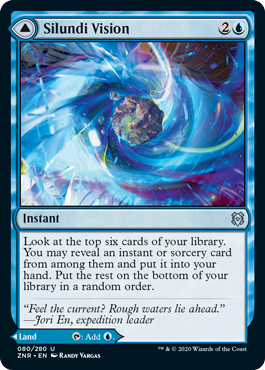
Sea Gate, Reborn 7
This is the first of the mythic cycle, the only 5 of the 30 that can enter untapped. This naturally makes the land very low cost to include. Likely only costlier as far as utility lands go than the otherwise free legendary lands from Kamigawa and of course Legends. I think these are lower cost than Barbarian Ring style pain lands, the check land style Castles or even the new Adventures manlands. The effects that come from this mythic cycle are also relevant and powerful and should be significant. All this initially led me to believe most would be cube staples. What in fact transpired is that most are barely ever cast due to being so costly. This ultimately makes them lower impact than the Castle cycle. I did cast Sea Gate Restoration more than I was expecting to but still not much and it only averaged about 2.5 cards... Sometimes you just had to hold it as cycling for 7 felt abysmal. This was the first of the cuts from my main cube due to this low mana efficiency and lack of ability to affect the board. Much as it is the weakest for more normal cubes it is one of the better ones in my combo cube and goes very nicely with cards like Omniscience.
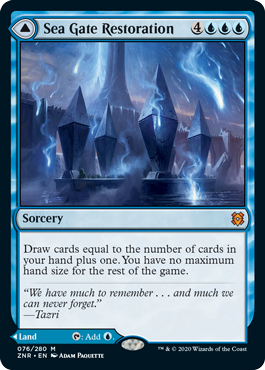
Emeria, Shattered Skyclave 7
I think this is the second most cast of the five mythic MDFCs however I have only seen it go on to win once or twice! A sub 10% win rate for a seven mana spell is awkwardly bad. I still feel a bit like despite a decent amount of testing that is somewhat down to bad luck but even so, the figure isn't getting over 50% any time soon and that is still no good for a seven drop. Tokens are not great and this is the kind of power you can get for five mana in cube. Even so this is a lot of board presence and should do work offensively as well as defensively. There is a chance this simply isn't getting used properly yet but again, it isn't like it is the most complicated card. It has seen play in all the kinds of deck and so perhaps it is just a weaker cube card than it looks? Things are setup well to answer vanilla dorks and tokens in most cubes. You are still paying 7 mana and a card for some tokens. Even if the angels both take a card to kill odds on you are well behind in tempo on the exchange.
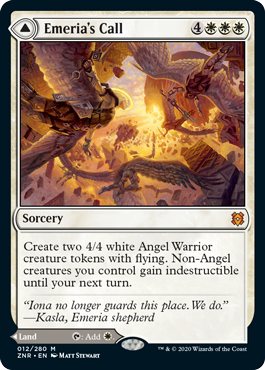
Glasspool Shore 7.5
This is very powerful but it is quite a high risk card. When you copy a Cavalier of Gales, a Whirler Rogue, or even just a Sea Gate Oracle, it feels great. Too often however it has no targets and is just a bad land. This low floor and somewhat win more ceiling is what led me to cutting this. The average performance was certainly good enough to merit cube inclusion, it just has a less than desirable play pattern on top of being quite the luxury card.
Agadeem, the Undercrypt 7.5
This stands out as one of the most surprising underperformers. It looks flexible and powerful. You can play it early compared to most of the mythic cycle as well. The problem with this is simply that it is the least cast of the cycle by a decent margin. Either you have the wrong sort of cards in the bin or your bin is getting disrupted or you just never get there. It is super rare to have the mana, not have better cards in hand, have the targets in the bin, all while still holding this. Should all those things line up you get a very efficient play. Spend six mana to put six mana's worth of stuff into play and go up three cards. All very good but rarely very threatening. You are getting medium sized dorks, value dorks, and utility dorks when really you want something with a really high threat level. Sometimes you get the dream of Blood Artist, Nested Shambler, and Woe Strider and that is enough to take the game but mostly this is a painful land. Best use for this is in Death's Shadow builds where it gets back relevant cards or assists with lowering your life total.
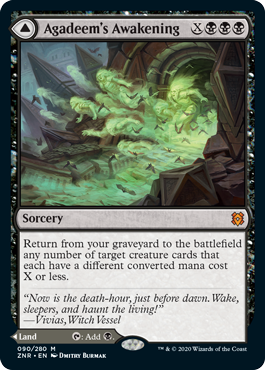
Turntimber, Serpentine Wood 7.5
In many ways this is just a convoluted but highly convenient cycling land. It heavily beats all other cycling lands being able to enter untapped. The cycling mode can often come up costing effectively 2 or less when you play it and basically always hits gas which is of course what you want when cycling away a land. Sometimes you even get card selection out of the deal but in practice you tend to hit only a few dorks of which only one is a sensible pickup. You are looking for either a big expensive finisher or a strong three drop that ideally scales well with counters. I have seen this be a fancy Arc Lightning with Walking Ballista on more than one occasion. Finding a 5/4 Eternal Witness and having another spin on the Symbiosis the following turn is quite fun too. In practice this was still slightly too often a land and a bit too much of a luxury card. Green has a lot of tools to put lands into play or tutor them up and so it has a strong preference for things like Treetop Village and Kessig Wolf Run when looking to fill out utility land slots. I run this in my combo cube as there are vastly more obscene game winning fatties there but sadly had to trim it from my normal cubes. Both Agadeem's Awakening and Turntimber Symbiosis suffer from there being rather more black and green utility lands (about 5 each) I actually want in the cube than is the case for other colours. I suspect they might not yet have been cut had they only been competing against the number of cards white has in this area (a big 1 I think).
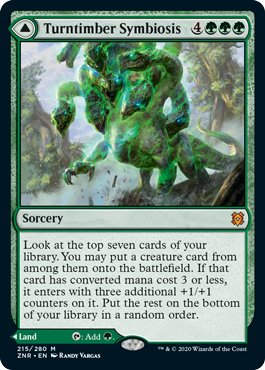
Bala Ged Sanctuary 8/10
This performed wildly above expectation. It is more of a security and comfort than alternatives but it has put up good results. It just does the best job of scaling into the late game while still being cheap enough to use sensibly in the midgame. When Regrowth is bad lands are typically good and from then on it just gets better. Green can afford more than most paying three extra mana for a spell it wants. Regrowth effects have always been better it singleton formats. This is option rich and lets you lean harder on big win cards like Ugin or Emrakul that bit more. It also not only lowers the risk of self mill cards but scales up when paired with them. I really like what this card brings to cube. The power is lower than some of the cards it is above in this list but the suitability and performance have seen it get a lot more play and do a lot more impressive work. Since this arrived the play Eternal Witness gets has fallen off a cliff. People want access to a Regrowth but need it rather less than they thought. It isn't that this is more powerful than Witness. It is just both more suitable and more useful.

Tangled Vale 8/10
Another very low powered offering that is just spot on for suitability and convenience. Ramp is great but it is great early and it is only doing anything for you provided you are also making land drops. That is the real strength of this card. While it isn't what you call good ramp it is sufficiently good enough. It only costs two and has no hoops or drawbacks. It is just a Llanowar Elf for an extra mana and that is OK when part of a modal card. When you don't have the land drops for ramp to actually be ramp this is just a nice safe land instead to make that drop with. Ramp is a very powerful thing to do in magic but the problem it has always had is consistency. You need to curve your mana and have a balance of ramp and overcost stuff. Miss that ramp or land drops and your top end is dead. This being either of those key setup components adds a critical element of safety to ramp strategies. One of the modes is always good early and either mode can remain good into the mid and late game. Oddly the body becomes useful again to a small degree in the late game in that it is usually better than a land. It can hold an equipment, provide a chump block, or perhaps trigger a Guardian Project / Great Henge. Oddly the card reminds me a bit of Sakura Tribe Elder. It has the drawback of needing to survive to be ramp but it gets to be ramp and a dork as the game goes forward and it doesn't need there to be basic lands to find. It is also effectively only 1 mana when you would miss the land drop compared to Tribe Elder. Yes, Elder is absolutely still the better card overall but it is a lot closer than you might think.

Pelakka Caverns 8/10
This is much more about being playable hand disruption than it is about being all that good. If you knock a mana off the cost of most cards on this list they generally start to look like the top end versions of those effects. This barely attains the unimpressive heights of Transgress the Mind. Hand disruption is pretty much the only non-blue means there is in magic to handle things like instants or sorcieries, things that are problems on cast rather than in play. It is a key part of what people play black for and an important balancing act on the general magic metagames. You don't need loads but you do want some. The issue in cube is that there isn't enough of it. Most other colours have a good ten decent one drops that do the colours thing. Black struggles to cobble together more than 3 good cube worthy one mana discard spells. Discard spells are also trickier to include in lists than most other styles of card thanks to how quickly they can become dead, this is part of why you only want some rather than loads. The high demand and easily dead aspects of discard combine to mean that once you are past the really good cheap discard effects you are looking for rather more from your card overall. Usually modality of some kind, be that direct as per Collective Brutality and Doomfall or something as simple as cycling like Memory Leak. Predation goes for the cleanest option of being a land which does a lot to solve the narrowness issues. It then gets a big boost from becoming a discard spell that is generally playable. That is how both Predation and Memory Leak get away with being so low powered and still get cube attention. Both also have the perk of being usable cards without prior access to black mana making them ideal splash cards.
Predation gets a lot of out information. The two main times it is played are against bigger slower decks where you are expecting to hit something big and mean like an Ugin or a Confluence, alternatively you play it against a quick deck when you find things out. Sometimes an early Kitesail Freebooter will reveal a card you are going to struggle to beat and so you take a turn out from acting on the board to ensure you don't fold to a specific threat. This can even be assumed knowledge such as when you lose to some massive Promised End style threat in game one so you save up Predation and fire it off the turn before they could Emrakul you in the face. Predation is never something I feel great about having to play but it has saved so many games and done so much work that it is hard to deny its value. It is very much a safety tool of the deck. Ideally not needed and a bit of a phaff like checking the batteries in your smoke alarms. When it is needed however you are glad of having bothered!
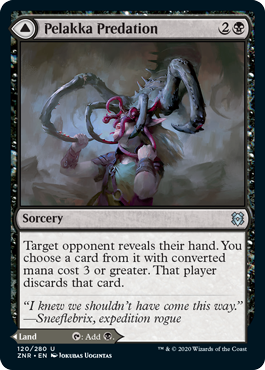
Kazandu Valley 8/10
This is one of the rare examples on this list that kind of just makes the cut based on power. There is no real pressing need of a big fat vanilla dork. Cube is all about things that serve a purpose, or multiple where possible. Big dumb dorks like this don't really do that. You could just be playing a Tireless Tracker and gaining value or an actual threat that has a significantly better chance of ending a game. Mammoth makes up for not being something you naturally look for in a cube card by being substantially more mana efficient than all the other MDFCs. If this were two mana for example it would really raise some eyebrows. At three is still isn't at all unreasonable. It often comes down on turn two anyway and thanks to swathes of sac lands and Rampant Growths the average attacking power of Mammoth is over five. Mammoth offers lots of options and lots of consistency. It helps you to curve relevantly by being a powerful means to spend three mana or a land drop. It lets you decide how much pressure to apply and how much to extend, or indeed, which direction you wish to spend your resources on developing. One of the most obnoxious openers in my cube at present involves making a turn two Mammoth and a turn three sac land allowing for a Great Henge to be freely deployed all while hitting them for 7! Mammoth mostly gets killed but that in itself is good. It is only three mana and is sufficiently threatening to bait removal. Normally this is bad on vanilla dorks as you are getting nowhere trading no better than 1 for 1. With Mammoth you can just make it as a land if you don't want to walk into something. That choice on how you use it turns a drawback into more of an upside.
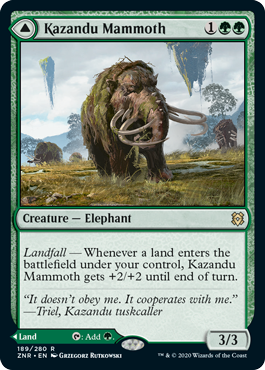
Hagra Broodpit 8/10
Early in the game this is about 3.7 mana, later in the game it is so close to 4 it might as well be. This, like Pelakka Predation, it not a very mana efficient spell. It is however a really useful piece of interaction and security. They play quite similarly in that they save a lot of games but never feel great when used. You rarely pull ahead with these safety net tools, you just get to stay in the game with them. Mauling is typically better because killing creatures is good in basically all matchups and doing so scales up in value as the game progresses. Not only do you kill bigger badder things in the late game you also suffer less ill effects from playing a card with such poor mana efficiency. Indeed, this can even become a good tempo play when it is killing something like a Vorinclex. Most decks that are at least half black will benefit from Mauling and Predation being added with one spell and one Swamp removed. They just add so much security, options, and consistency, that they are well worth the cost. MDFCs with this high level of utility thanks to key desirable effects make you deck feel and play as if you cast a nice card quality spell or two. Like starting every game with a Once upon a Time in hand! Mauling and Bala Ged Recovery both do a lot better than they look like they should thanks to having the multiplier effect of positive scaling effects lining up. Unlike the other good MDFCs these two are at their best later in the game which is typically when you need land least. Normally that effect just scales against the cards and hinders their performance a little. It is the smaller effect and so overridden by the more important scaling factors, mainly, that of offering important options early. The point here is just that Mauling and Recovery perform better than you might expect if you were just comparing mana efficiencies to other good MDFC cards. This is one of those examples of the subtle and unique scaling effects mixing it up and giving unexpected results.
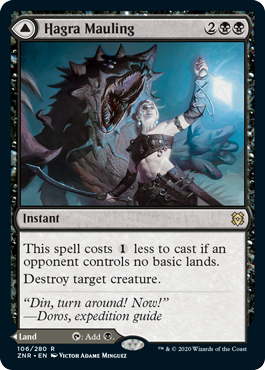
Spikefield Cave 8.5/10
I am somewhat stunned that this is the third best MDFC. I always knew it would be super playable but I kind of assumed it would be rather lower down the list thanks to having such small amounts of nominal power. It turns out that the impressive synergies this card has are what propel it to over perform so much. The low power is countered pretty hard by the land option of making Cave. When the ping isn't enough you are generally happy with your land. A card for a land is the going rate and so despite being a weakish land it is still far far closer to the mark than a ping in a vacuum, the value of which clocks in at about half a cards worth at best. When a ping is good however it is great. It is a nice instant way to trigger all those prowess cards. Torbran helps Hazard to do good work! It is a favoured land to pitch with Seasoned Pyromancer thanks to the 1/1 it generates in doing so. The exile utility can be huge too when used to properly answer The Scarab God or just prevent some annoying on death trigger. Red often needs to combine damage sources to remove things and Hazard is a clean and cheap way to help reach a threshold. Hazard lets you build a list that is substantially more robust against green mana dork openers and aggressive 2/1 beaters without having to fill up on low impact one drop answers. This is just a perfect utility card as the effect is so direct and broad and able to complement what red is up to. Being one mana vastly increases the playability as you can cast it in so many little windows. I am pretty confident I will play this in any mono red deck I might build in my cube whenever I have it in my pool. Equally I will happily play this in plenty of multicoloured decks as well, not just those mono lists.

Jwari Disruption 8.5/10
Where Lonely Sandbar and Censor meet. For my money I rate this a bit above Censor and I think they are both outstanding cards. Particularly in a cube setting. Force Spike (and Mana Tithe of course) is the best of the Spikes in a constructed setting simply down to cost. Force Spike is great but it quickly loses value with both time passed in a game, and information gained by the opponent. This lead to the card being very polar in performance, either it would just win the game for one mana by answering a key card at negligible cost, or it would be dead. So much so that to realistically include Force Spike in a list you need a decent bit of card quality, or at least other uses for a dud card. This all rather reduced the pick and inclusion rates of Force Spike and so I elected to cut it. Easily powerful enough for cube, essential in some of the quicker and more broken ones, but just not the kind of card that leads to good game play. Enter Censor and Jwari Disruption. These cards are fantastic replacements for Spike in cubes. The slower speed isn't too big of an issue outside of powered cubes and helps at one end of the scale to reduce the polarity of the card. It is never quite such a free win nor safety net from the get go. At the other end of the scale the inbuilt ability to cash in your Spike for another card is exactly what the doctor ordered and further calms the polar play patterns of Force Spike cards (to also include the likes of Daze and Disrupt). Disruption and Censor help you feel safe while getting set up early. They provide a rich pot of options. They are reasonably likely to be able to answer something in the first five or so turns of the game bolstering that all important ability to interact early. Most importantly they are convenient to build with as they increase the consistency of the deck while needing no support. They feel like very low cost inclusions while offering quite a lot back in return.
So, why is Disruption better than Censor? Well, for starters it is also a Lonely Sandbar as well as a Censor remember. There are a lot more hands I can keep where I have Disruption in it rather than Censor, or at least the risk of doing so is a whole lot less. There are of course all the general reasons I covered at the start about why MDFCs (that have both sides as useful in the deck) have a leg up on cycling cards generally. There is also the nature of the decks you play these cards in, typically control decks that are looking to use low cost tools to stay in the early game without diluting the power of the deck. Control decks love a land drop and are typically happy to make them as often as they can. Yes, Censor is better if you are flooding out late but that isn't common compared to the many other situations you might find yourself in. There is also the aspect of holding the Spike effect. Just because it is getting later in the game or your opponent has a bunch of mana doesn't necessarily mean the card is dead. They may well still walk into it. Holding a Censor up for this possibility is generally wrong and you want to cycle it off as soon as you have spare mana once you think it is unlikely to do good work. Disruption on the other hand can often be held till the last land, sometimes the penultimate. I commonly lay a basic or other EtB untapped land instead of Jwari Ruins even though I have no real expectation of getting that big hit with it. The opportunity cost of holding it up is just that much lower and so you hold it and so you occasionally wreck people with a late game Force Spike and that all serves to significantly increase the performance. There is also the aspect of deck depletion. Cycling a Censor thins the deck, which can be great if Thassa's Oracle is a win condition but can also just feel a bit dodgy in some of the longer games. Disruption gives you this cycling effect without thinning the deck which means you get to retain a higher average power as well as a higher nominal power too, the latter of which Censor doesn't achieve. Filling up the bin early can be nice but then Censor isn't the ideal card for you as early is typically when you want to hold your Force Spike. Mental Note and Opt is more where you should be looking if early bin filling is a desire. Censor certainly isn't bad there, you might still well be playing it, but it just isn't the top of the pile. That is kind of the point here, these cards are very playable and very effective. I will play either or both pretty happily and very often in most blue decks I build.
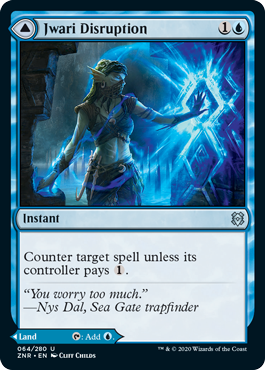
Shatterskull Smashing 9/10
The comfortable best of the lot and somewhat expected from the outset with this style of card. It simply combines a versatile and highly desired affect with a land that has practically no downside. Even if you need to pay the life cost, you are red, you can afford it. The lack of the mountain type is more of a problem for you and it still isn't one. This is played in every red deck with any semblance of an ability to produce double red. Shatterskull is the most diverse in how it is used as Smashing is deployed from 3 all the way to 8 relatively smoothly while Hammer Pass is also flopped out at all sorts of times. Certainly more earlier but Hammer Pass does still come out late and retains use throughout most games. Smashing is almost unreasonably good as it able to gain card advantage and sometimes even tempo while also being a disruptive tool. In the mid game being just a Forked Bolt or Arc Trail is situationally game ending and often just good. Just being a Volcanic Geyser taking out one important target at a slow and over priced rate is also often still good. Where the card gets foolish is when you get to 8 mana and can take out a pair of massive things. I have felt unbeatedable with a pair of high loyalty planeswalkers before and just outright lost to this. There are few cards that can take out multiple walkers at the same time and fewer still that can offer such a range of modes and playability. It turns out the Mountain, Arc Trail, Finale of Eternity, and The Elder Spell modal card is a good one. A long long time ago a in playtesting one of the group brought along a deck where he was using Swamps to proxy for Wrath of Gods. As the night progressed it was noticed that Swamp had made its way into play, the player was mocked and an in-joke was born. It was just so self evident that a land/Wrath split card was just too good. Twenty years down the line and we are as good as there with some of these MDFCs, Shatterskull being the best rather comfortably. The only bad thing I have to say about Smashing is that sometimes you get get your land Thoughtsiezed and that can be awkward. Obviously that applies to all MDFCs so it isn't something we can directly take away from the card. When it comes to this card, just put it in your deck and enjoy the free wins and the general consistency boost. It really has that Lutri vibe of being a little too good for how little it costs you to play.
